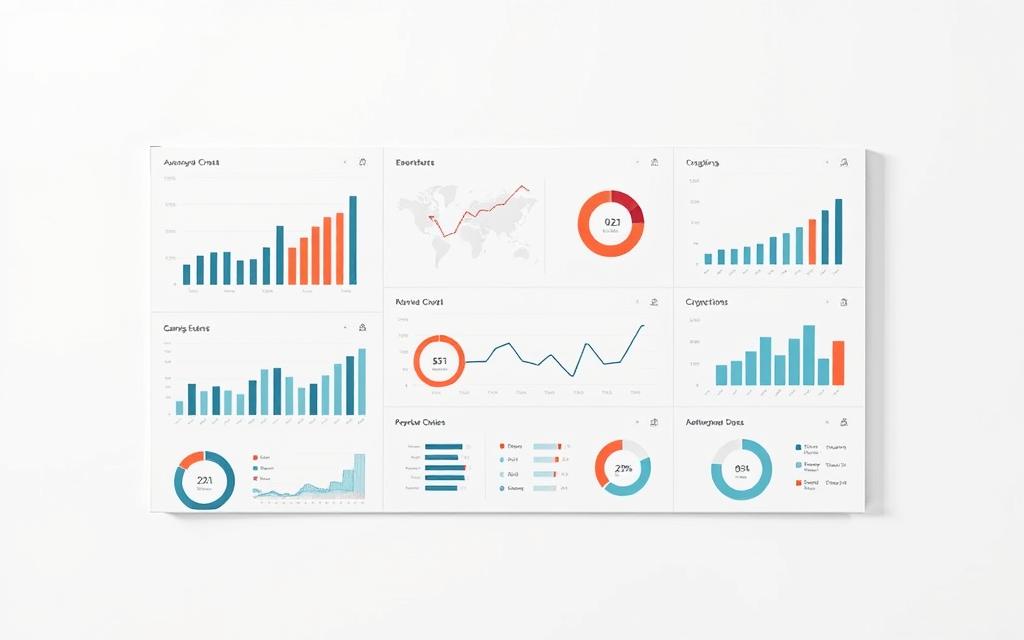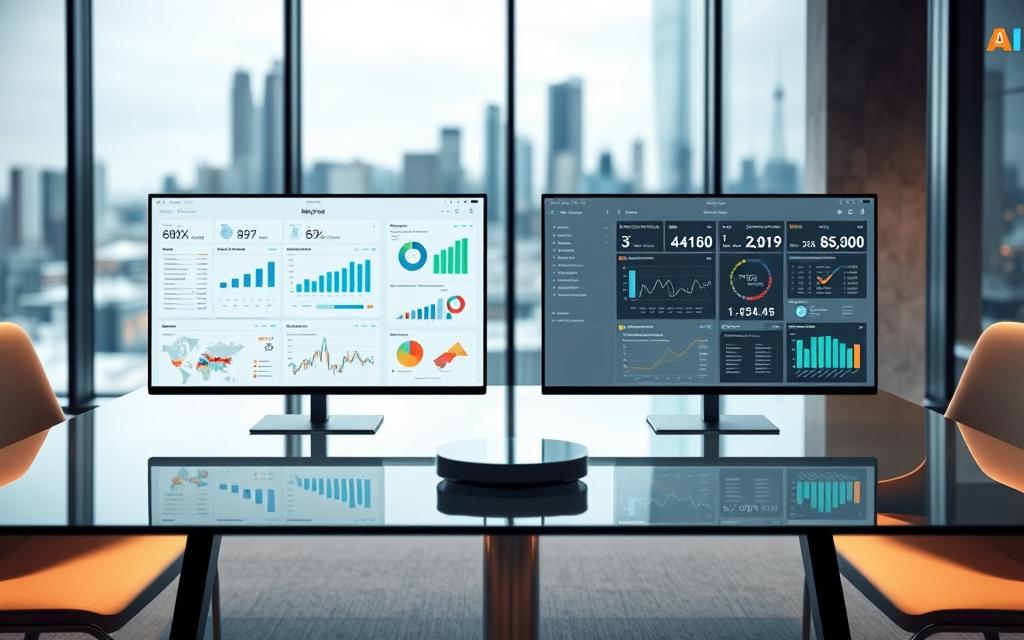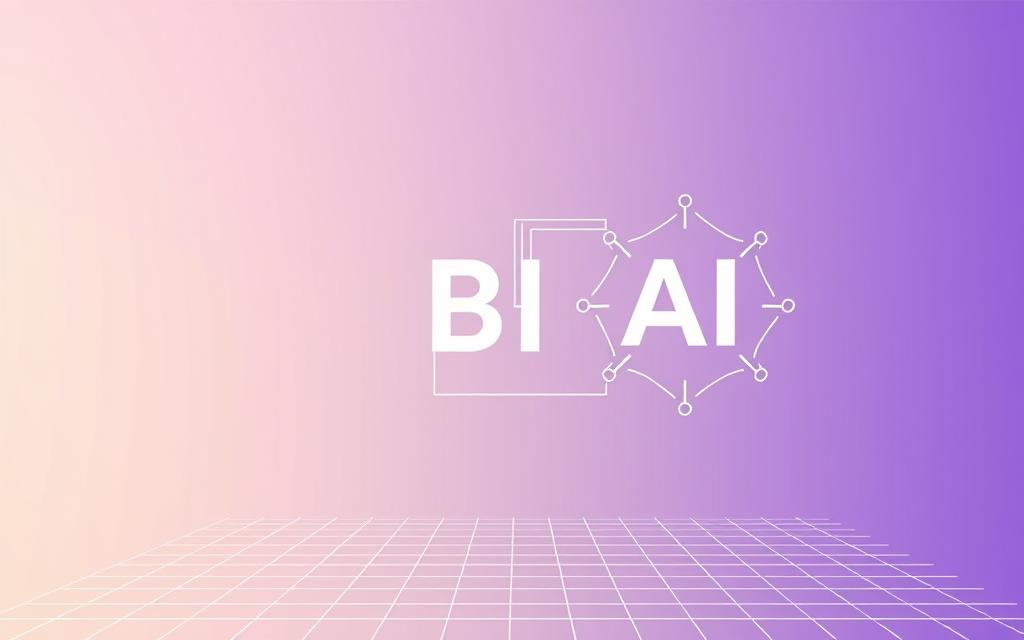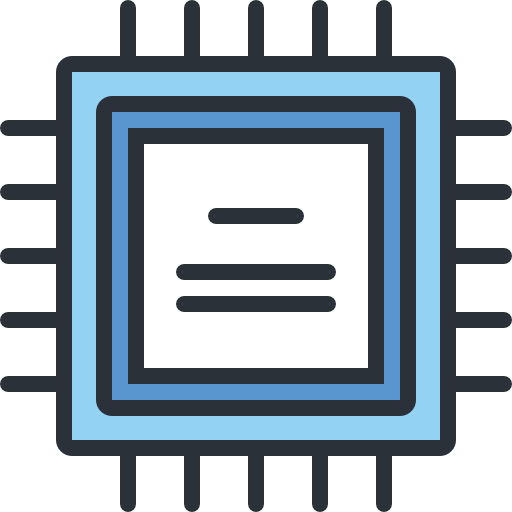Business Intelligence vs. AI: Key Differences Explained
Modern enterprises rely on data-driven decisions to stay competitive. Companies like PayPal and John Deere showcase the power of advanced analytics in real-world applications. While both technologies process information, their approaches vary significantly.
Business intelligence focuses on structured data, delivering insights through dashboards and reports. Tools like Power BI help organizations analyze historical trends, as seen with Univision’s 80% advertising yield growth. This approach requires human interpretation for strategic planning.
Artificial intelligence leverages machine learning to predict outcomes and automate processes. Retailers use AI for personalized marketing, while financial institutions apply it for fraud detection. Unlike traditional methods, AI handles unstructured data like images and natural language.
These technologies work best when combined. Predictive analytics from AI enhances BI systems, creating comprehensive solutions for complex challenges. The result? Faster, smarter decisions across every industry.
The Definitions of AI and Business Intelligence
Data-driven strategies rely on distinct yet complementary technologies. Business intelligence transforms raw data into visual reports, helping teams track performance. Tools like Tableau organize historical trends into dashboards for quick insights.
Artificial intelligence goes further, simulating human reasoning. Through machine learning, AI systems adapt and predict outcomes autonomously. Retail giants use these capabilities for real-time inventory adjustments.
“AI’s strength lies in processing unstructured data—like social media posts—where traditional BI tools struggle.”
A key AI component is natural language processing (NLP). This allows systems to interpret human speech, enabling voice-activated queries. Meanwhile, BI excels with structured datasets, like sales records.
For a deeper BI and AI comparison, explore how these technologies intersect. BI’s descriptive analytics meet AI’s predictive power, creating a holistic view.
How Is Business Intelligence Different from Artificial Intelligence?
Organizations leverage distinct analytical approaches for decision-making. While some tools focus on past performance, others predict future trends. Understanding these differences optimizes strategic planning.
Descriptive vs. Predictive Analytics
Business intelligence tools like Tableau summarize historical data. Reports and dashboards require human analysts to identify patterns. For example, retailers analyze seasonal sales to adjust inventory.
Artificial intelligence uses algorithms to forecast outcomes. Machine learning models process real-time data, like credit card transactions, to flag fraud. This reduces reliance on manual reviews.
Human Decision-Making vs. Autonomous Systems
Traditional methods depend on human decision-making. Analysts assess risks in financial services using static reports. This approach is thorough but slower.
Autonomous systems operate 24/7, like chatbots resolving customer queries instantly. However, ethical concerns arise with bias in algorithmic judgments.
| Feature | Business Intelligence | Artificial Intelligence |
|---|---|---|
| Data Type | Structured (sales records) | Structured & unstructured (social media) |
| Speed | Human-paced | Real-time |
| Primary Use | Performance tracking | Predictive modeling |
Combining both methods enhances business processes. Historical insights guide AI predictions, supporting data-driven decisions at scale.
The Role of AI in Business Intelligence
Retailers and manufacturers gain an edge through automated insights. AI elevates traditional analytics by processing vast datasets faster than human teams. This shift unlocks predictive analytics, turning historical data into future-ready strategies.

Automating Data Processing
Neural networks excel at spotting patterns in chaotic datasets. For example, e-commerce platforms analyze 10,000+ SKUs to detect micro-trends. Traditional regression models miss these nuances, while machine learning adapts dynamically.
Case in point: A major retailer slashed forecasting errors by 50% using AI. Real-time adjustments in supply chains minimized overstock and shortages. Automation also freed analysts to focus on strategic decisions.
Enhancing Forecasting Accuracy
AI’s ability to learn from historical data refines predictions. Retail inventory systems now achieve 40–60% higher precision. Unlike static reports, AI tools update forecasts as new data flows in.
“Deep learning models process weather, social trends, and sales simultaneously—something manual methods can’t replicate.”
This agility supports industries from finance to logistics. The result? Faster, data-backed decisions with fewer human errors.
Advantages of AI in Business Intelligence
Advanced analytics reshape decision-making by bridging gaps between data and action. AI-powered tools enhance traditional BI systems, delivering faster, more accurate insights. Three key benefits stand out: democratized access, reduced errors, and adaptability to diverse *business needs*.
Democratizing Data Access
Natural Language Processing (NLP) lets non-technical teams query data using plain English. For example, sales managers ask, “Show top-performing regions,” and get instant visual reports. This eliminates dependency on IT teams, as seen with OpenDialogue’s 40% faster response rates.
Reducing Human Error
AI automates data cleaning and analysis, minimizing manual mistakes. Retailers using machine learning for inventory see 30% fewer discrepancies. Algorithms flag anomalies like pricing errors or fraud, ensuring reliable *customer insights*.
Supporting Broad Business Needs
From HR to manufacturing, AI adapts to sector-specific challenges. Dynamic pricing models analyze 200+ data streams, adjusting costs in real-time for *competitive advantage*. Predictive maintenance in factories cuts downtime by 25%, saving millions annually.
| Feature | AI-Enhanced BI | Traditional BI |
|---|---|---|
| Accessibility | NLP-driven queries | Static dashboards |
| Error Rate | <1% (automated) | 5–10% (manual) |
| Adaptability | Real-time to *market changes* | Historical focus |
For teams exploring AI tools, combining *predictive prescriptive* analytics with BI creates a future-proof strategy. The result? Agile, data-driven organizations ready for tomorrow’s challenges.
Traditional BI: Strengths and Limitations
Financial institutions demonstrate BI’s enduring value in audit processes. Traditional BI systems power 89% of regulatory reporting, ensuring compliance across industries. These tools transform structured data into standardized formats for auditors and stakeholders.

- Audit-ready documentation with full traceability
- Predefined dashboards for financial statements
- Role-based access to sensitive records
Monthly reporting cycles reveal systemic constraints. Legacy systems often take weeks to process quarterly filings. This latency hampers real-time decision-making in fast-moving markets.
“Our fraud detection workflows improved 300% after migrating BI to the cloud, but regulatory reports still require on-premise systems.”
Structural limitations persist. Most tools analyze less than 30% of available enterprise data. Unstructured inputs—like customer emails—require manual preprocessing before data analysis.
| System Type | Processing Speed | Data Flexibility | Compliance Fit |
|---|---|---|---|
| Cloud BI | Real-time | High (APIs) | Moderate |
| On-Premise BI | Batch processing | Low (fixed schemas) | High |
Banking workflows showcase this duality. While loan approvals use modern analytics, FDIC reports still depend on traditional BI. This hybrid approach balances innovation with regulatory certainty.
Looking ahead, business process leaders must weigh these tradeoffs. Structured reporting remains essential, but emerging technologies address historical gaps.
AI vs. Traditional Business Intelligence
The evolution from descriptive to predictive tools reshapes organizational strategies. Where conventional methods analyze past performance, advanced systems forecast future trends. This shift delivers 83% more actionable recommendations, transforming decision-making processes.

Data Handling Capabilities
Traditional systems function like rear-view mirrors—perfect for examining historical roadmaps. They organize sales records into quarterly reports, helping retailers spot seasonal patterns. However, these tools struggle with live social media feeds or customer call transcripts.
Machine learning acts as a crystal ball, processing diverse data streams simultaneously. Financial institutions now run risk simulations across 200+ variables, something impossible with manual methods. The outcomes? Planning cycles shrink from months to weeks.
Analysis Types and Outcomes
Prescriptive analytics revolutionize inventory management. AI tools don’t just predict demand—they recommend optimal stock levels per store. Walmart’s system adjusts merchandise weekly, reducing overstock by 30%.
Contrast this with traditional dashboards that show what sold last quarter. While valuable for compliance reporting, they lack real-time adaptability. The table below highlights key contrasts:
| Capability | Traditional BI | AI-Driven BI |
|---|---|---|
| Data Types | Structured records only | Text, images, sensor data |
| Speed | Batch processing | Real-time streams |
| Output | Static reports | Dynamic recommendations |
| Error Rate | 3-5% (manual entry) | <0.5% (automated) |
Retailers showcase this transformation best. AI-driven merchandising analyzes weather, trends, and local events simultaneously. The result? Hyper-relevant promotions that boost sales by 18-25%.
The Complementary Nature of BI and AI
Synergy between analytical technologies creates unprecedented operational advantages. Integrated systems deliver 47% more accurate insights than standalone tools, with 92% adoption rates across enterprises. This powerful combination transforms raw data into actionable strategies.

Business intelligence serves as the foundation layer for advanced implementations. Historical sales data, customer records, and financial statements provide the training material for machine learning models. Retail giants like Target use this approach to predict inventory needs six months ahead.
Continuous feedback loops enhance predictive accuracy. AI algorithms analyze real-time transactions while referencing BI dashboards for context. Banks leverage this for fraud detection—comparing live activity against historical spending patterns.
Hybrid architectures dominate modern analytics platforms. Microsoft Power BI now incorporates Azure AI, allowing:
- Automated anomaly detection in quarterly reports
- Natural language queries against structured datasets
- Dynamic risk scoring based on market trends
“Our sepsis prediction model achieved 89% accuracy by combining AI with EHR analysis. Traditional methods topped at 63%.”
The healthcare sector demonstrates this integration perfectly. Patient outcome predictions merge with electronic health records (EHR), creating data-driven decisions that save lives.
| Component | BI Contribution | AI Enhancement |
|---|---|---|
| Data Foundation | Cleansed historical records | Training datasets |
| Analysis Speed | Batch processing | Real-time streaming |
| Output Type | Standardized reports | Personalized recommendations |
Enterprises adopting both technologies gain competitive edges. Predictive analytics powered by AI complement traditional reporting, creating comprehensive solutions for complex challenges.
Strategic Implementation of AI in Business Intelligence
Strategic integration of AI transforms enterprise analytics workflows. Companies like Wellthy achieve 300% faster insights while cutting costs by $200k annually. Successful adoption requires careful planning across two critical phases.
Assessing Organizational Requirements
Begin by identifying high-impact use cases. Retailers often prioritize inventory forecasting, while banks focus on fraud detection. ThoughtSpot’s research shows 89% of successful implementations start with specific pain points.
Key evaluation factors include:
- Data readiness: Assess quality and structure of existing datasets
- Process gaps:
- Manual reporting bottlenecks
- Latency in decision cycles
- Skill availability: Balance between citizen data scientists and specialists
“Our AI agent reduced query resolution from hours to minutes by focusing on finance team pain points first.”
Evaluating Solution Options
Modern platforms offer 150+ connectors for seamless integration. Compare these critical dimensions:
| Factor | Cloud-Native | On-Premise |
|---|---|---|
| Scalability | Elastic resources | Fixed capacity |
| Total Cost | OpEx model | High CapEx |
| Innovation Speed | Auto-updates | Manual patches |
Natural language processing capabilities prove essential for non-technical teams. Walmart’s multi-cloud deployment uses NLP to let managers ask questions like “Show underperforming categories” without SQL knowledge.
Mitigate vendor lock-in risks by:
- Choosing tools with open APIs
- Maintaining data portability
- Requiring transparent machine learning model access
Retail leaders demonstrate this balanced approach. Macy’s hybrid architecture combines cloud-based data analytics with on-premise reporting for regulatory compliance.
Real-World Applications of AI and BI
Leading companies harness cutting-edge analytics to solve complex challenges. Retailers optimize inventory while banks combat fraud with unprecedented accuracy. These practical implementations showcase the power of combined technologies.
Retail and Customer Insights
Personalized shopping experiences drive modern retail success. Amazon’s recommendation engine analyzes browsing patterns to suggest relevant products. This predictive prescriptive approach boosts conversions by 35%.
AI-powered systems track market changes in real-time. Walmart adjusts pricing dynamically across 5,000+ stores. The result? Competitive positioning without manual oversight.
- Demand forecasting reduces overstock by 40%
- Sentiment analysis improves product placement
- Chatbots handle 70% of customer inquiries
Financial Forecasting
Barclays slashed fraud losses by 89% using algorithms that detect anomalies. The system processes millions of transactions instantly, flagging suspicious activity. Traditional methods miss these patterns.
Monte Carlo simulations transform risk management. Banks model 10,000+ scenarios to stress-test portfolios. This data analysis technique provides clearer investment guidance.
“Our AI tools cut financial planning cycles from weeks to days, giving executives faster insights.”
| Application | Technology | Impact |
|---|---|---|
| Credit Scoring | Machine Learning | 25% fewer defaults |
| M&A Targeting | Predictive Analytics | 50% faster deals |
| Regulatory Reporting | Automated BI | 90% time savings |
Fintech innovations demonstrate this evolution. AI-powered BI tools now assess creditworthiness using non-traditional data points. The approach expands financial access while reducing risk.
Future Trends in AI and Business Intelligence
Analytics landscapes evolve rapidly as emerging technology redefines possibilities. Gartner predicts 80% of BI platforms will incorporate artificial intelligence by 2026, while Edge AI adoption grows at 28% annually. These shifts promise transformative impacts across industries.
Augmented analytics becomes mainstream, automating data preparation and insight generation. Tools like Tableau now suggest correlations without human input. This democratization lets marketing teams uncover patterns as effectively as data scientists.
Generative AI converges with traditional platforms, enabling natural language queries. Users ask “Show Q3 risks” instead of building dashboards. Machine learning models even draft executive summaries from raw datasets.
“Ethical governance frameworks will separate industry leaders from followers as AI adoption accelerates.”
Quantum computing looms as the next disruptor. Early tests process 10,000 variables simultaneously—impossible with classical systems. Automotive firms already prototype quantum-enhanced route optimization for connected vehicles.
The table below contrasts current and future capabilities:
| Dimension | Current State | 2026 Projection |
|---|---|---|
| Analysis Speed | Minutes-hours | Milliseconds |
| Data Types | 80% structured | 60% unstructured |
| User Interaction | Dashboards | Voice/chat |
| Automation Level | 30% tasks | 75% workflows |
Real-world implementations showcase this evolution. BMW’s factories now predict maintenance needs using sensor data from 500,000 vehicles. Such future trends blur lines between operational systems and analytical tools.
Conclusion
Successful organizations blend historical insights with forward-looking predictions. Business intelligence delivers clear snapshots of past performance, while artificial intelligence unlocks future opportunities. Together, they form a complete analytics toolkit.
Companies like Improvado showcase this synergy. Their AI Agent merges traditional reporting with real-time recommendations. The result? Faster, more accurate data-driven decisions.
To stay ahead, consider these steps:
- Audit existing analytics capabilities
- Identify high-impact AI integration points
- Train teams on hybrid tools
This strategic approach ensures competitive advantage as future trends evolve. Assess your technology stack today to unlock tomorrow’s potential.













